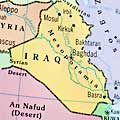 Historically, Iraq has never been a cultural monolith.
Historically, Iraq has never been a cultural monolith.
The fertile crescent, where the Tigris and Euphrates meet, on the frontier between the Persian empires and the Arab world, Iraq has been a home and a haven for a diverse blend of religious communities, languages, ethnic minorities and tribes.
The major minorities of Iraq include:
Christians Iraq’s Christians include Chaldeans, Syrian Orthodox, Syrian Catholic, Assyrian Orthodox Church of the East, Armenians and Roman Catholics. According to the Brookings Institution there were between one million and 1.4 million Christians in Iraq before the 2003 American-led invasion. Best estimates today are that half that number remain, many of them internally displaced. Many of the Christians, particularly the Chaldeans and Assyrians who speak Syriac and Aramaic (the language Jesus spoke), trace their roots back to ancient Mesopotamian peoples who were in Iraq before the Apostle Thomas brought Christianity and before Arabs swept in during the seventh century.
Jews There were once more than 15,000 Jews in Baghdad, and their history in Iraq goes back 2,600 years. Arab nationalism, on the rise since the Second World War, resulted in their persecution and expulsion. When Israel was created by the United Nations in 1948, Zionism was outlawed and sometimes punished with death. It only required two Muslim witnesses to convict a Jew of Zionism. If possible, things actually got worse for the few remaining Jews after 2003. In a Reuters report in 2008 it was estimated there are fewer than 10 Jews left in Iraq.
Palestinians More than 90 per cent of Palestinians are Sunni Muslims. As the Shia majority has sought to assert its political power the Palestinian refugees have been more and more unwelcome.
Before 2003 there were about 35,000. They arrived as refugees from the Arab-Israeli war of 1948, the Arab-Israeli war of 1967, and from Kuwait and other Gulf States during the first Gulf war of 1991.
Though not awarded Iraqi citizenship, they were given subsidized housing, were exempt from military service and enjoyed other privileges under Saddam Hussein’s Baath Party rule. In the new Iraq, both their Shia neighbours and government officials have let the Palestinians know their special status is a thing of the past. Beatings, disappearances and a requirement to constantly renew short-term residency permits sent Palestinians streaming toward the Syrian border. But Syria, with its own Palestinian refugee population of 450,000, was not about to let them in.
The Palestinians were stopped at the border and initially kept in a typical refugee camp — tents in the desert — on the Iraqi side of the border. Eventually they were moved to two other tent camps just inside Syria, on the condition they couldn’t leave except to be resettled in a third country.
The al-Tanf Syrian camp was closed on Feb. 1 this year, leaving the UNHCR with just its al-Hol camp in northeastern Syria.
Canada is the number two destination for the Iraqi Palestinians. The UNHCR has referred 219 Palestinians to Canada over the last two years, and 60 of them have actually come to Canada. Sweden is the number one Palestinian destination, with 619 cases submitted to the Swedes and 413 departing for Sweden.
Sabian Mandaeans Followers of John the Baptist and inheritors of the gnostic religious tradition that also manifested itself in both Christianity and Judaism in the ancient world, the Sabian Mandaeans have their own language, art traditions, religious literature and traditions — traditions that include an absolute ban on violence and weapons, even for self-defence. Most of the world’s 60,000 to 70,000 Sabian Mandaeans lived in extended families in Iraq before 2003. Fewer than 5,000 remain.
Yazidis Neither Kurds nor Arabs, the Yazidis have had their territory claimed by both groups.
The Yazidis are great synthesizers of religion who have adopted parts of Zoroastrian, Christian, Jewish and Muslim mythology and customs, but their basic world view is inherited from the Manichean religion that swept the world between the third and seventh centuries.
Declared impure by numerous Sheiks and Imams, the Yazidis have been the most persistently and viciously persecuted minority in Iraq since 2003. Car bombs, a weapon normally used in big crowded cities, have been set off in Yazidi towns and villages. Between 2005 and 2007 the Yazidi population dropped from 700,000 to 500,000.
Turkmen Traditionally a tribal people who occupied the northern area of Iraq, the Turkmen find themselves in a struggle with the Kurds and the Arabs for control of oil-rich Kirkuk. They’ve formed the Iraqi Turkmen Front (ITF) in the hope of creating an independent Turkmeneli state.


 Historically, Iraq has never been a cultural monolith.
Historically, Iraq has never been a cultural monolith.